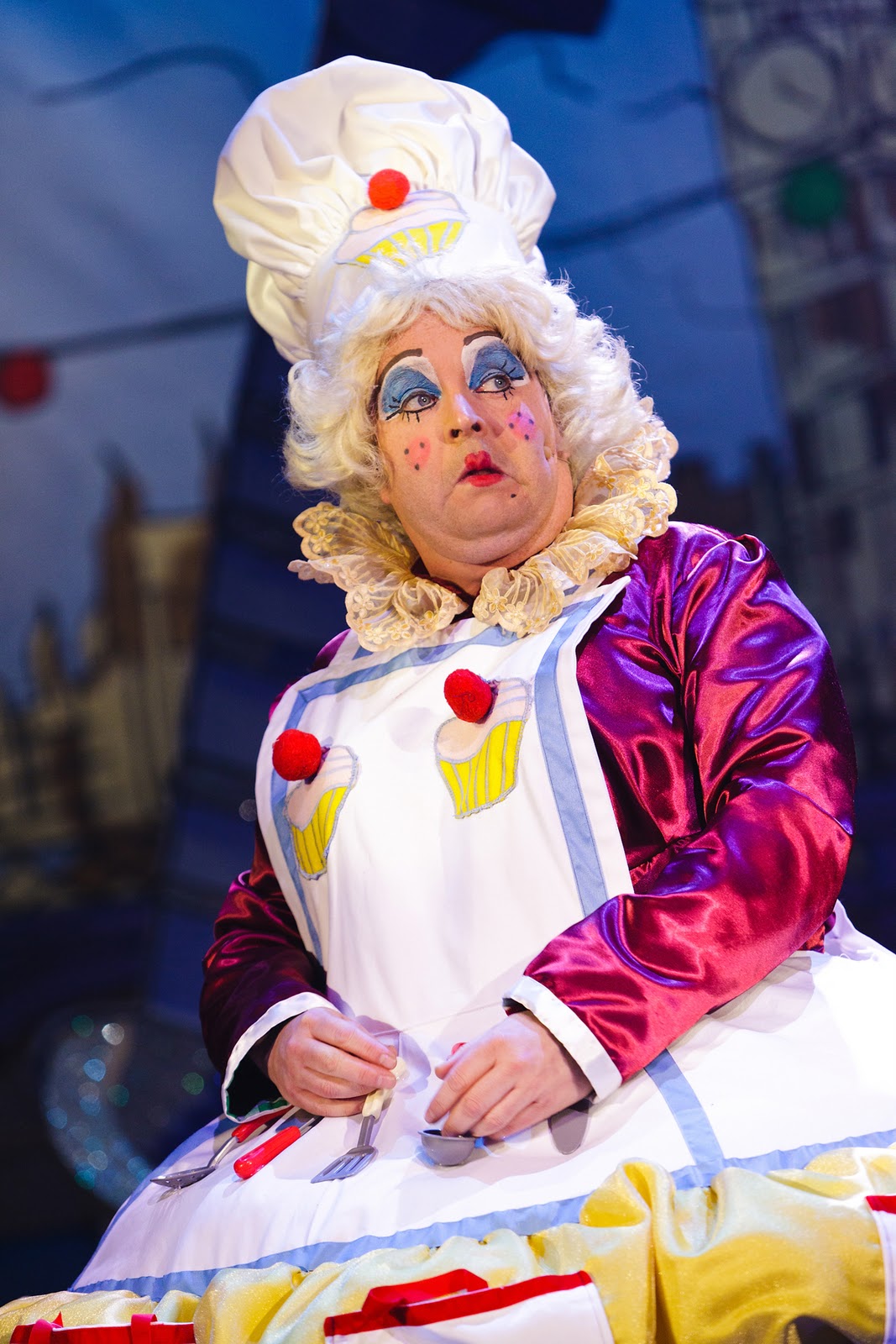[h2]THE BEGINNING [/h2]
The origins of British Pantomime or “Panto” as it is known in the UK, probably date back to the middle ages, and blend the traditions of the Italian “Commedia dell’ Arte, and the British Music hall to produce the art form that is Pantomime. Such was the success of Commedia in England that intense rivalry soon sprang up between the theatres producing it. Within two days of a new performance opening at Lincoln’s Inn Fields Theatre in 1716, a show with an almost identical title opened at the Theatre Royal in Drury Lane. This was the first tenuous beginning of English pantomime. And now this peculiar form of entertainment is as much a part of Britain’s heritage as roast beef and Yorkshire pudding, Buckingham palace and the tower of London, warm beer and cricket. Most towns and cities throughout the UK play host to a production of pantomime around the Christmas period. And they are performed in venues, ranging from the top theatres in the land, to local village halls and community centres. And whether it is a lavish professional performance, or a local amateur dramatic production, all are well attended. Modern pantomimes are predominantly aimed at children, and are nearly always based on well-known children’s stories, such as popular fairy tales or folk legends. The most popular subjects are “Cinderella”, “Aladdin”, “Dick Whittington” and “Snow White”. Other popular titles include “Jack & the Beanstalk”, “Sleeping Beauty”, “Babes in the Wood” [usually combining the legend of Robin Hood] and “Peter Pan”. Pantomime is a thriving business in the UK. And large theatres vie with each other for “star” names that will attract full houses, providing much needed revenue for box offices throughout the country.
[h2]THE PLOT [/h2]
The plot is very simple: The girl dressed as a boy who is the son of a man dressed as a woman, will win the other girl (surprisingly dressed as a girl), with the assistance of a person(s) very often dressed in an animal skin. Try explaining that to an American, German or someone from the Far East. Whether the show is set in China, the Never-Never-Land or the City of London it will contain all the aspects regarded as necessary to a pantomime.
[h2]THE ‘DAME’[/h2]
The principal boy part was one well-established theatrical convention; an even older one was that of men playing female roles. After women moved onto the stage at the time of the Restoration, a tradition still remained of men playing some comic female roles. A million miles away from the drag act, the Dame is a study in female eccentricity. George Lacy is said to have started the tradition in 1923 of the Dame changing her costume constantly and indeed, prior to that time, costume changes were rare. The Dame’s entrances are also more extravagant and exaggerated than any other character. Always played by a male member of the cast, dressed in drag; this character is usually portrayed as oldish, unattractive and fairly common, all qualities which she believes she is the exact opposite of! She befriends the two principals early in the story and is usually instrumental in all the good acts they perform in the course of the story; and quite often ends up “living happily ever after” either with the Principal Girl’s kindly old widowed Father/Uncle/Guardian or with the ultimately-reformed Principal Baddie. The pantomime dame character emerged from out of the Victorian Music Halls usually cast as the hero’s mother. Examples are Widow Twankey in “Aladdin” or “Dame Trott” in Jack and the Beanstalk. The public loved to see well-known comedians playing the role of Jack’s mother, or Sarah the cook in Dick Whittington [back then, women comedians were practically unheard of] and the tradition has stuck ever since. The Dame is also known for wearing outrageous costumes, and these are often used to good comic effect, by parodying the fashions of the day. The Panto Dame should exude warmth and comedy, even pathos, but is never required to do any “dirty Deeds”.
[h2]‘GOODIES’ AND ‘BADDIES’ [/h2]
The fairy Queen and the Demon King appear in all pantos, although their exact guise and title may differ. From Old King Rat to modern Fairy Liquid, Peter Pan and Hook, names vary according to the location and topicality of shows, but certain stage directions nearly always hold strong. Good enters from stage right and Evil from stage left. This tradition of Evil entering from the sinister side goes back to the mystery plays and the few working star traps [through which the demon used to be projected in a puff of smoke] can always be found in the down stage left position. This tradition seems to echo medieval times, when the entrances to heaven and hell were placed on these sides. Tradition also dictates that the villain should be the first to enter, followed by his adversary the good fairy. The story nearly always revolves around the tried and tested formula of good conquering evil and requires the principal baddie to make all the innocent characters lives a misery, from the beginning. Usually by the end of the show, all the baddies and their henchmen will have either been destroyed or be made to see they error of their ways and turn into reformed characters.
[h2] THE ‘PRINCIPAL BOY’ [/h2]
The other element of “Traditional” pantomime is the “Principal boy” role [mainly played by a female] although the role is that of a boy hero. The female playing the principal boy usually dresses in short, tight fitting skirts [the shorter and tighter the better] accompanied by knee-high leather boots and fishnet stockings. This provided a marvellous opportunity, in ages past when female attire went down to the ankles, to display a shapely pair of limbs and to increase the male audience. It was very common in both Regency and Victorian extravaganzas, both of which played a part in the shaping of pantomime, for women to play, more or less, any male role that they fancied. The Hamlets and the Romeo’s have been well documented, but it is not so commonly known that in the 19th century women appeared as Falstaff, Richard III, Protruchio, Shylock, and Don Giovanni. The principal boy lives on as the sole survivor of the male impersonator in the theatre and even beat off the challenge of the swinging sixties. Norman Wisdom took the name part in “Aladdin” at The London Palladium in 1946/7 and was followed in the next decade or so by a wave of pop stars. It was left to Cilla Black to reclaim the tights and boots in 1971, since which time the principal boy role has generally remained in the hands [or legs] of the ladies.
[h2]THE ‘PRINCIPAL GIRL’[/h2]
Nearly always played by the prettiest female in the cast, and is traditionally portrayed as the epitome of youth and innocence. Although in more modern times has begun to be portrayed as a more feisty character, and less as the pathetic and helpless female of yesteryear. She will usually be called upon to sing a solo. And always ends up “living happily ever after” with the Principal Boy.
[h2]THE ‘UGLY SISTERS’ [/h2]
Unlike the dame, the Ugly Sisters always have to tread a thin line between comic characters, and out and out villains. The ugly sisters are of course an intrinsic part of the Cinderella story. But versions of them can be found woven into in other pantomimes. The first portrayal of the ugly sisters was done by women, but they were soon superseded by men. And like the dame, this has become a tradition that never changes.
[h2]THE CHORUS AND JUVENILES [/h2]
The element of song and dance in Pantomime is extremely important. And Pantomime wouldn’t be the same without its chorus of singers and dancers, and troupes of juveniles. Today the average chorus in a small provincial pantomime can number as little as eight. Some shows manage to get by with as little as two professional dancers, supplemented by adult juveniles. Conversely, the chorus/juveniles in amateur productions can vary enormously depending on the enthusiasm and support in any given community. Some amateur groups can have upwards of thirty juveniles in the chorus.
[h2] ANIMALS [/h2]
Every memorable pantomime contains them – and not always the type we have come to expect. The animals in pantomime are usually depicted by speciality turns in “skins”. It is true to say that some of the greats started their careers by literally playing the back legs of the pantomime horse. Many years ago at the Hippodrome Theatre, Stockport, the front end of the horse was a young man named Charlie Chaplin. Animals have always enlisted the audience’s sympathy and support.
[h2]SLAPSTICK [/h2]
“Slapstick” takes its name from a device used in these early entertainments, especially in “Harlequinades” Harlequin was considered to have magical powers. And carried with him a sword made of wood, which alternated, between being a weapon and a magic wand. This sword or bat had a hinged flap, which created a very loud “slapping” noise when used, generally to give a more theatrical effect when used to slap fellow actors. John Rich’s Harlequin would hit the slapstick against the scenery to make the scenes change by knocking down a series of hinged flaps. The chase scene would take the characters too many different locations all controlled by Harlequin’s magic bat. The locations of the chase were often places that people would recognise – named streets or areas of London for example. They also included mythical locations. The pantomime traditions of slapstick [meaning a certain type of clownish physical comedy] chases, speed and transformations were developed from Rich’s Harlequinades. Slapstick eventually developed into modern form involving the throwing of custard pies, and squirting of water.
[h2]TAB SCENES [/h2]
Tabs scenes, or ‘transformation scenes’ are played out in front of the middle curtains or ‘tabs’. They started as a way of moving between the different sections of the pantomime. Rather than just stopping one section and starting another, actors found ever more creative and imaginative ways to continue the story until the necessary scenery changes had been made. During these scenes, the actors would take off the giant head masks that they had worn for the story and remove their costumes to reveal themselves as the Commedia dell’art characters. As pantomime developed and stage technology became more advanced the transformations became events in themselves. Stage designer, William Beverley, first used the transformation scenes to alter stage sets. Scenery was flown in from above on wires or changed by a series of hinged flaps. Trick objects turned around to become another object. Beverley introduced a ‘fan effect’ where the scenery collapsed sideways and inwards, like a folding fan, to reveal a view from behind.
[h2]AUDIENCE PARTICIPATION[/h2]
I have left this section to last as it probably sums up what pantomime means to most people in the UK. Audience participation is as an important part of English pantomime tradition, as anything I have previously mentioned. And even the most staid members of the audience, suddenly become unrestrained in their enthusiasm to take part. The audience is actively encouraged to boo the villain whenever he enters, argue with the Dame, and warn the Principal Boy when the villain is behind them, by shouting out “He’s behind you!” Below is a typical example of this in action. Ugly sister. “I’m much prettier than Cinderella” Audience -”Oh no you’re not!” Ugly sister – “Oh yes I am!” Audience -”Oh no you’re not!” This back and forth verbal jousting between the actors and the audience is an integral part of ‘panto’, and can happen several times throughout the show. Sometimes the actors will even leave the stage and move amongst the audience to continue this repartee.
[h2] THE FUTURE [/h2]
Pantomime has survived, by adapting many elements of theatre. The element of “novelty” has always been an important factor in achieving this, as has its ability to incorporate modern trends and topicality within its structured framework. And by successfully weaving these into its format, it remains one of the most popular forms of entertainment in the UK. There are probably as many different explanations of pantomime and its history, as there are changes of the dame’s costumes. Pantomime is a living, growing art form. The Commedia Dell’art from which it is derived has all but died as, eventually, does all theatre which becomes fossilised. Pantomime has survived by taking and expanding from the new ideas that each age has given, and we hope this gloriously eccentric British institution continues to do so. “Oh yes we do!





